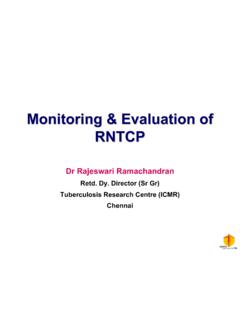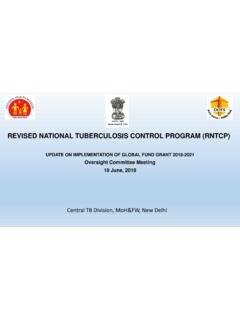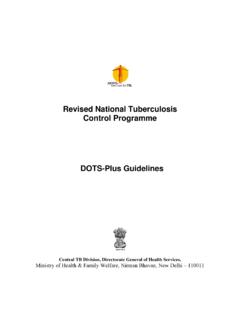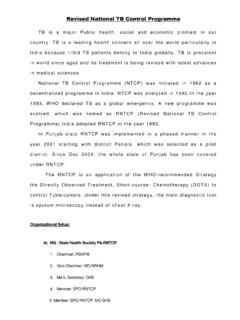Transcription of Modules 1–4
1 Managing theRevised national tuberculosis control Programmein Your AreaA Training CourseCentral TB DivisionDirectorate General of Health ServicesMinistry of Health and Family WelfareNirman Bhavan, New Delhi 110 011 Modules1 41 Course Introduction2 Ensuring Identification ofTuberculosis Suspects3 Supporting Laboratory Services4 Administering Treatmentmanaging the revised national tuberculosis control programmein your areaA training courseModules1 4 Central TB DivisionDirectorate General of Health ServicesMinistry of Health and Family WelfareNirman Bhavan, New Delhi 110 0111 Course Introduction2 Ensuring Identification of tuberculosis Suspects3 Supporting Laboratory Services4 Administering TreatmentFirst printing, January 1998 Second printing, July 1999 Third printing.
2 June 2000 Diagnosis and ManagementCOUGH FOR 3 WEEKS OR MORE3 Sputum smears3 or 2 Positives1 Positive3 NegativesAntibiotics1 2 weeksX-raySymptomspersistTBNegative for TBX-rayNegative for TBTBS putum-positive TBAnti-TB TreatmentNon-TBSputum-negative TBAnti-TB TreatmentCONTENTS1 COURSE INTRODUCTIONP urpose of the training 3 Extent of the tuberculosis 5 Aim of the revised national tuberculosis control 7 Structure of the revised national tuberculosis control 9 Central TB 9 State level .. 9 District 10 Sub-district 12 Health 13 Structure of exercises of the training 15 Definitions: The revised national tuberculosis control 162 ENSURING IDENTIFICATION OF tuberculosis 19 Importance of properly identifying tuberculosis 22 Exercise sputum from tuberculosis 26 Guidelines for collecting 27 Tasks performed before sputum 27iiiivTasks performed during sputum 29 Tasks performed after sputum 31 Transport of sputum 32 Refer patients for diagnosis or further 34 Exercise Workbook E1.
3 Laboratory Form for Sputum 393 SUPPORTING LABORATORY 45 Monitor documentation related to microscopy 46 Explain the importance of limiting administrative 46 Make sure laboratory technicians keep slides for 46 Explain the importance of accurate recording of results ofsputum smear examinations .. 47 Exercise Workbook E1: Laboratory Form for Sputum 50 Complete the tuberculosis Laborator y 52 Using the tuberculosis Laboratory 52 Check the accuracy of the tuberculosis Laboratory 53 Ensure that the New patients had three sputum samples examinedand that follow-up cases had two sputum samples 55 Spot-check results of sputum smear examinations for 55 Exercise that the laboratory quality control network is 62 Maintain an adequate supply of reagents and other 64 Make sure there is an adequate stock of reagents and other materialsin the laborator 64vExercise that contaminated materials are disposed of safely.
4 67 Conduct visits to microscopy 68 Prepare for visits to microscopy 68 Conduct the 69 Checklist for laboratory super 70 Exercise : Laborator y 734 ADMINISTERING 79 Complete tuberculosis Treatment 81 Record general patient 81 Record disease 82 Record type of 84 Record results of pretreatment sputum smear examinations of patientswho will begin treatment for 85 Record the patient s 86 Determine the category of 86 Table 1: Symptom-based approach to evaluation of possibleside-effects of anti- tuberculosis drugs used in the 91 Intermittent 92 Special 92 Record prescribed regimens, tablets and 93 Management of the tuberculosis 94 Record results of follow-up sputum smear 98 Table 2: Management of patients who were smear-negative at diagnosisand who interrupt 99 Table 3: Treatment for New smear-positive cases who interrupt treatment(Category I).
5 101 Table 4: Treatment for smear-positive retreatment cases who interrupttreatment (Category II).. 102 Record drug administration (intensive phase).. 104 Record drug collection (continuation phase).. 104 Record 105 Communicate with 106 Determine if a patient has been previously treated for 107 Provide health education to 108 Monitor drug 115 Ensure proper drug 115 Monitor drug collection and 117 Review tuberculosis Treatment 118 Exercise Workbook 120 Ensure all health workers use sterile syringes and 124 Sterilization of syringes and needles for streptomycin 124 Rules for 124 Exercise 127 Administer preventive treatment to 130 Table 6: How to proceed with preventive chemotherapy in childrenunder 6 years of age who were in contact with a smear-positive 131 Exercise 133 Annexure I.
6 tuberculosis Treatment 135 tuberculosis Treatment Card (Non-DOTS Treatment in DOTSA reas).. 137 Annexure II: tuberculosis Transfer 139viCOURSE INTRODUCTION111 COURSE INTRODUCTIONMANAGING THE RNTCP IN YOUR AREA2 COURSE INTRODUCTION31 PURPOSE OF THE TRAINING COURSET uberculosis (TB) kills more adults in India than any other infectiousdisease. More than 1000 people a day one every minute die of TB in has a long history of research and demonstration projects in , despite the existence of a national tuberculosis Programmesince 1962, the desired results have not been achieved. There isoverdependence on X-rays for diagnosis.
7 Treatment regimens used are oftennon-standard, and incomplete treatment is the norm rather than the recommendations of an expert committee, a revised strategy tocontrol TB was pilot-tested in 1993 in a population of million and wasthen extended to a population of million in 15 states/UTs in thecountry. In these areas, diagnostic practices improved with effective use ofquality sputum microscopy, and cure rates doubled as compared to thoseachieved with conventional treatment. Because of these encouraging results,the revised national tuberculosis control Programme (RNTCP) is beingextended, initially in a phased manner, to 102 districts covering apopulation of million.
8 By early 1999, the programme covered morethan 115 million goal of the RNTCP is to cure at least 85% of New sputum smear-positive patients detected, and to detect at least 70% of all such patientsafter the goal for cure rate has been met. To achieve these targets, thecentral, state, district and sub-district levels must each do their part. Amajor organizational change in the RNTCP is the creation of a sub-districtlevel. The sub-district will consist of a designated Medical Officer- tuberculosis control (MO-TC) who does tuberculosis work in addition tohis other responsibilities, as well as two full-time supervisory staff fortuberculosis work a Senior Treatment Supervisor (STS) and a SeniorTuberculosis Laborator y Supervisor (STLS).
9 The state, district and sub-district staff are responsible for organizing, implementing and supervisingthe RNTCP, and the success of the programme depends on course draws on two sets of WHO Modules : Managing tuberculosis atDistrict Level and Managing tuberculosis at national Level. Because ofIndia s size, many of the components from the national Modules areMANAGING THE RNTCP IN YOUR AREA4directly relevant to states and districts, and many of the district components are directly relevant to sub-districts. Therefore, this courseprovides training relevant to implementing the RNTCP at the state, districtand sub-district levels.
10 Staff who can benefit include state-level staff (StateTB Officer, director and staff of State TB Demonstration and TrainingCentre), district-level staff (District TB Officer, Medical Officer of theDTC), and the designated Medical Officer (MO) of the sub-district. Parts ofthe course are also relevant for other Medical Officers and for SeniorTreatment Super the end of this course, participants will be able to do the following tasks: train MOs and health workers to correctly identify patients who should beinvestigated for tuberculosis ; train health workers to properly collect and transport sputum specimens andrefer symptomatic patients for microscopy examination; monitor the maintenance of the tuberculosis Laboratory Register; monitor documentation related to microscopy examinations; complete tuberculosis Treatment Cards of patients; ensure proper administration of drugs.









